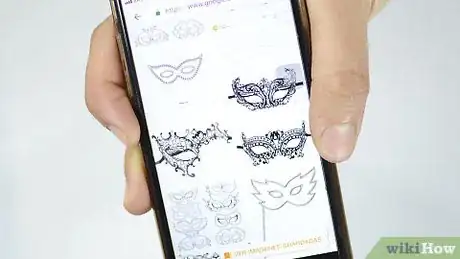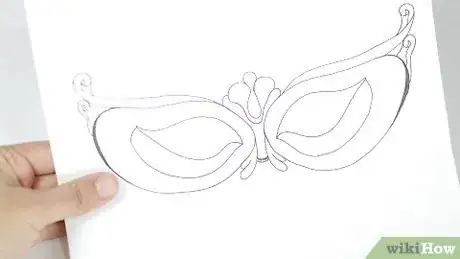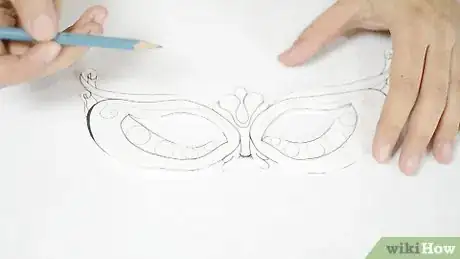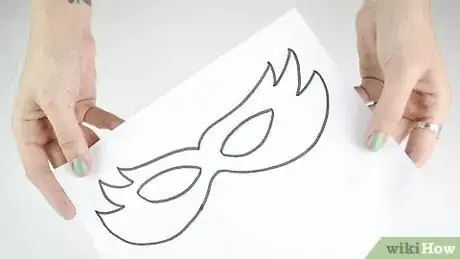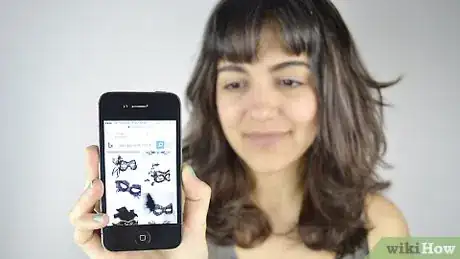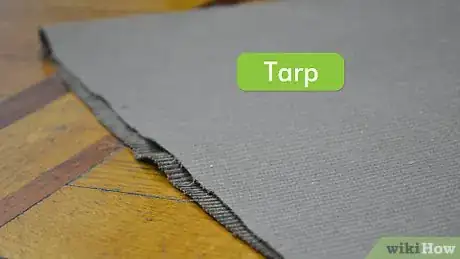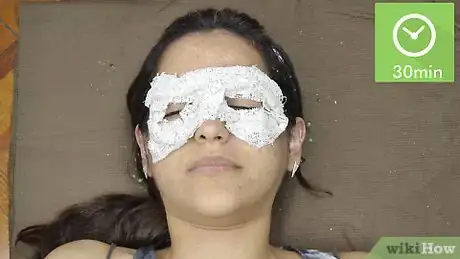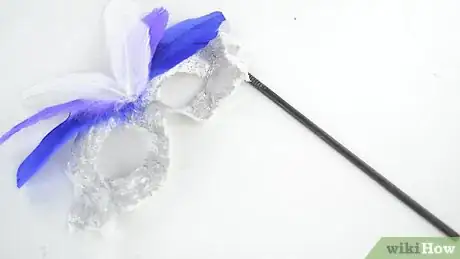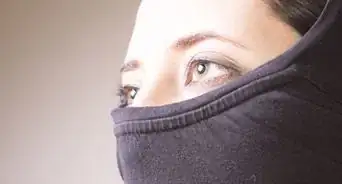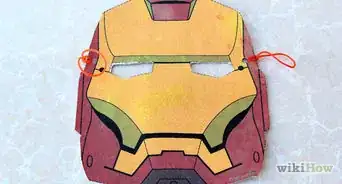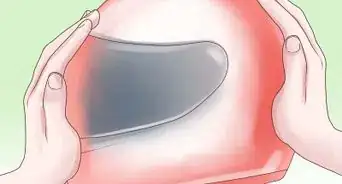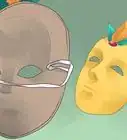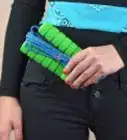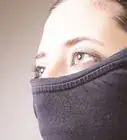This article was co-authored by wikiHow staff writer, Amber Crain. Amber Crain has been a member of wikiHow’s writing staff for the last six years. She graduated from the University of Houston where she majored in Classical Studies and minored in Painting. Before coming to wikiHow, she worked in a variety of industries including marketing, education, and music journalism. She's been a radio DJ for 10+ years and currently DJs a biweekly music program on the award-winning internet radio station DKFM. Her work at wikiHow supports her lifelong passion for learning and her belief that knowledge belongs to anyone who desires to seek it.
This article has been viewed 328,111 times.
Learn more...
Masquerade masks were first worn in the 15th century during the festive season of Carnival. During this religious celebration, people crowded the streets in costume to party before Lent. Today, masquerade masks are worn for all kinds of parties. The costumes include ostentatious masks of all shapes and sizes. The mask usually covers the top half of the wearer's face and is sometimes attached to a handle. You can make your own mask using thick paper, tulle, or plaster, and then decorate it any way you wish.
Steps
Using Paper or Cardstock
-
1Choose a mask template. Type "masquerade mask template" into Google and hundreds of results will pop up. If you've never made a mask before, you might want to start with a simple design. Choose a template with a plain outline and plenty of inner white space if you want to add a lot of customization.[1]
- The standard mask goes a bit above the eyebrows and ends at the top of the cheekbones, but yours doesn't have to.
- You can always draw your own design, but at least check out some of the templates for inspiration and guidance for sizing.
-
2Print your chosen template on thick paper or cardstock. For a sturdier mask, use cardstock, which you can get at any craft, art, or office supply store. Print the template out on letter-sized paper -- anything smaller won't accommodate the mask size, and anything bigger will just waste paper.[2]
- Before printing, make sure your printer can handle the thickness of cardstock, or change the settings to accommodate thicker paper.
- If you only have access to plain paper, try printing out several templates and layering them on top of one another to create a stronger base.
Advertisement -
3Add details to the outline (optional). Use a pencil and lightly sketch any additional elements you want onto the cardstock. Attaching flames or swoops onto the outline can make it more interesting and even change its shape entirely. Consider flames, swoops, hearts, stars, horns, and geometric shapes.[3]
-
4Cut out the mask. Be careful! Use a good pair of scissors to prevent any snags or tears. If you added extra elements, don't forget to include those when cutting around the template. Leave a little extra room on the sides if you are attaching a band or some type of holding device, like a dowel stick.
-
5Mark your mask for painting. If your template didn't come with design elements already in place, lightly sketch out what you want yours to look like. Creating a design for the surface of the mask might include multiple colors and textures. Sketching those outlines ahead of time will help you maintain symmetry.
- Make your marks light! You don't want to see them through your paint.
-
6Paint your mask with acrylic paint. The choice of color is a personal one, but traditional colors include deep reds and metallic hues. Use a small paintbrush to ensure clean lines. Paint on several coats to get a rich hue.
- If you're doing multiple colors, let one color dry completely before starting another one.
- Take care as you hold the mask; if your fingers touch the wet paint you could smear it (or get it on your clothes).
-
7Allow the paint to dry fully. Set your mask on a covered surface in an open area where it won't be disturbed. Be patient -- drying might take a while. Depending on the type and brand of paint you used, this could take up to 4 hours. It needs to be completely dry before you add anything else to it.
- Check the packaging of your chosen paint for specifics about drying time.
-
8Glue on your extras. Masquerade masks are traditionally loud and flashy, so use decorative materials like rhinestones, glitter, colorful feathers, sequins, gem-style stickers, curly ribbons, plastic gems, glitter glue, and anything else that interests you. Stick with your originally planned theme and don't overcrowd the surface.[4]
- What you choose is totally up to you, but do consider weight, bulk, and tackiness. Too many embellishments may leave your mask looking overdone.
-
9Paint and adorn your dowel to match your mask. Feathers are the tradition adornment for dowels, but you can use strings of pearls, leaves, or any embellishment you see fit. If you don't have a dowel, you can use chopsticks, a firm straw, or a very carefully rolled up piece of card.[5]
-
10Use a hot glue gun to attach the handle to the back of the mask. The position of the handle is unimportant. Some masquerade masks have handles coming from the middle, others have them from either side, and some masks have no handle at all. It's up to you!
- Allow the glue to dry fully. Hold the dowel in position for 30 seconds to make sure it's secure and in place.
-
11Attach a string instead of a dowel for a hands-free option. If you'd rather not hold the mask up to your face constantly, attach a string or ribbon so that you can tie it on instead. Use a hole punch to make small holes on both sides of the mask. Then, thread the string through the holes.[6]
- Be careful taking it on and off so that you don't tear the paper!
Using Tulle, Lace, or Sheer Fabric
-
1Print out your chosen mask template. With this method, you can print out a template that has a great amount of detail. It will take longer, but you'll be able to include as much detail as you'd like.[7]
-
2Tape a piece of wax or parchment paper over the template. Clear a space much wider than the template on a flat surface, then place the paper on the surface. Cover it with a piece of wax or parchment paper. Make sure the template is covered on all sides and can't move around underneath.[8]
- If your template slides around, try taping the edges down to the table, too.
-
3Tape tulle or your chosen fabric over the wax paper. The fabric should be much bigger on all sides than your template. It does not have to be perfectly centered; it just has to be bigger. If you don't have tulle, you can use lace or another sheer fabric of your choice. Tulle is stiffer and easier to work with it, though.[9]
-
4Trace the the lines of the template onto the fabric with fabric paint. If this is your first mask, you may want to stick to using one color of paint. Shake the paint bottle to remove air bubbles from the tip. Trace your pattern with the fabric paint right onto the tulle, taking care to create smooth lines. Start with the eye details first, then work your way out to the edges.[10]
- The paint gives your fabric mask definition and style. You can skip it and just have a plain fabric mask, if you prefer.
- Be careful not to rest the edge of your hand on the template as you apply paint!
- If you do use more than one color, be aware that the colors may run together where they meet. You may want to do one color first, let it dry, then apply the other.
-
5Let the paint dry overnight before cutting out the mask. Touch the paint lightly to ensure it's dry. If it is, pick up the template, wax paper, and tulle. Use sharp scissors to carefully cut around edges of mask and the eye holes. Cut through all 3 layers, including the wax paper.
-
6Peel the tulle away from the wax paper. Once you've cut out the mask, gently pry the fabric away from the wax paper. You can now toss out the template and wax paper and work just with the fabric.[11]
-
7Cut slits and add a ribbon for a fancy strap. First, cut two 1⁄4 inch (0.64 cm) slits each side of the mask. Then, cut two pieces of ribbon 20 in (51 cm) each in length. Go for ribbon that's .25 in (0.64 cm) wide so that it will easily fit through the slits you created. Thread each ribbon through one of the slits, then knot it through the other slit to secure it in place.[12]
- You can trim the ribbons shorter if you like, just make sure you try it on first so you don't trim off too much.
-
8Use fabric glue instead of cutting slits for an easier option. If you want something simpler, skip the slits and simply glue your ribbons onto the mask with fabric glue. Simply spread a little bit on the tips of each ribbon. Attach them to the mask and hold them in place for a few seconds so the glue can bond. Let the glue dry for 1-2 hours.
Using Plaster
-
1Grab a friend or helper. This technique requires 2 people -- one to apply the plaster, the other to act as the mold and have the plaster applied to their face. Whoever acts as the mold should be someone who can hold still for 30 minutes to an hour while the plaster dries.[13]
-
2Choose and sketch out your mask design. Do you want a full mask or a half mask? Do you want a basic face shape, or will you add horns or other details? Will you incorporate rhinestones or other embellishments? Decide ahead of time and sketch out your design before you start working with the plaster.[14]
- If the person acting as the "mold" is slightly claustrophobic or under the age of 5, a half mask is recommended.
- If your design is intricate, you may want to let your helper apply the plaster to your face. That way, it will be perfectly molded to your face shape. If it's pretty basic, either of you can act as the "mold."
-
3Pull back the person's hair and apply petroleum jelly on their face. Tie or slick back their hair to keep it out of the way. Apply a layer of petroleum jelly on their face. Be generous -- if you miss an area, it may hurt when you're taking the plaster off.
- The plaster will not pull out eyebrow hair -- just be liberal with your application of the petroleum jelly!
-
4Arrange a comfortable spot on the floor and for the person to lay on. Lay a tarp, sheet, or old comforter on the floor. Have the person getting plastered lay down flat on it. Make sure they are comfortable enough to be still for 30 minutes to an hour.[15]
-
5Cut and wet your strips of plaster. The strips need to be long enough to cover sections of the face, so cut them to be about 5 in (13 cm) each. Once cut, fill a bowl with water and place it next to you. You will dunk the strips in the water before applying them.[16]
-
6Apply strips until you have attained the mask shape you want. Start applying over large areas of the face first, like the forehead. Dunk the strips in the bowl of water, one at a time, before applying them to the face. Smooth out each piece as you put it on.[17]
- Take extra care around your eyes -- leave a little more room than you need.
-
7Add embellishments or additional shapes (optional). Once you've built a solid base layer, create any additional pieces, like horns or ears. To create a shape, cut it out from a piece of cardstock and glue it on. Attach more plaster on and around it until it's smooth. If you're using embellishments like beads or jewels, place them where you want them and then secure them with tiny pieces of plaster.
-
8Let the plaster dry for 30 minutes to an hour. Have the person lay as still as possible during this time. They'll be able to feel the plaster contracting as it dries, which may be slightly uncomfortable. When the plaster starts to become itchy and feels dry to the touch, it's ready to be removed.[18]
-
9Loosen up the mask by scrunching your face over and over. The movement of your face and the jelly will slowly ease the mask off your face. Set the mask aside to dry more thoroughly. Give it several hours to cure.[19]
-
10Attach a dowel. The easiest way to do this is with a wooden chopstick, but any stick-like object will do. Glue it on and place plaster strips over the tip to secure it. Smooth over it and let it dry completely.
- When you're finished attaching the dowel, allow it to dry overnight.
-
11Use sandpaper to smooth the surface. Start grinding away to smooth the rough areas on the mask using fine grit sandpaper. It doesn't have to be perfect, but this will remove the grainy, granular look of the plaster. Wipe the dust off with a cloth and spray with a coat of clear paint to seal. Let it dry.
-
12Paint it with acrylic paint. It may be wise to stick to one color, especially if this is your first mask-making experience. Most masquerade masks employ only one color scheme. However, you can do whatever you want! Let the paint dry for about 30 minutes.[20]
- Once you're done painting, you may want to include a top coat of glitter spray. It adds a nice finishing touch.
-
13Add embellishments to the dowel. These will cover the tip of your dowel and make your mask look professional and stylish. Try using bows, feathers, ribbons, and jewels.[21]
Community Q&A
-
QuestionHow can I make a mask that I can comfortably wear over glasses?
 Community AnswerTry making the mask around the glasses - but be careful and only use adhesive you know you will be able to take off to get your glasses back to normal.
Community AnswerTry making the mask around the glasses - but be careful and only use adhesive you know you will be able to take off to get your glasses back to normal. -
QuestionWhy are there no colors?
 The_Noble_JediCommunity AnswerIf you want color, paint it on or use colored paper.
The_Noble_JediCommunity AnswerIf you want color, paint it on or use colored paper. -
QuestionHow do I make tulle mask that sticks without using ribbon/elastic strings?
 Cecilia FloresTop AnswererIt all depends on how heavy your mask is, how long you're going to wear it, and what conditions you're going to be in. If it's very light (made out of just paper or lace and some feathers), you're only wearing it for 3-4 hours, and it's not raining, use eyelash glue. Use an oil to remove it at the end of the day. If it's medium weight, you're wearing it for 3-7 hours, and it's not too cold or raining, use spirit gum. If it's heavy and you're wearing it for a long time, use Pros-Aide. This adhesive can withstand moisture, cold, and heat. Both Pros-Aide and spirit gum are special effects makeup adhesives that are a tad more expensive and require a special remover.
Cecilia FloresTop AnswererIt all depends on how heavy your mask is, how long you're going to wear it, and what conditions you're going to be in. If it's very light (made out of just paper or lace and some feathers), you're only wearing it for 3-4 hours, and it's not raining, use eyelash glue. Use an oil to remove it at the end of the day. If it's medium weight, you're wearing it for 3-7 hours, and it's not too cold or raining, use spirit gum. If it's heavy and you're wearing it for a long time, use Pros-Aide. This adhesive can withstand moisture, cold, and heat. Both Pros-Aide and spirit gum are special effects makeup adhesives that are a tad more expensive and require a special remover.
Warnings
- Some paints can irritate the skin. Be aware of the types of paint you're using and the proximity to your skin.⧼thumbs_response⧽
Things You'll Need
With Paper or Card
- Thick paper or cardstock
- Printed template
- Scissors
- Paint
- Pencil
- Paintbrush
- Hot glue
- Dowel
- Decorative materials
With Tulle or Sheer Fabric
- Printed template
- Wax or parchment paper
- Tape
- Tulle
- Scissors
- Fabric paint
- Ribbon
- Fabric glue
With Plaster
- Plaster wrap
- Bowl of water
- Petroleum jelly
- Scissors
- Tarp or sheet
- Card (optional)
- Acrylic paint
- Dowel
- Embellishments (feathers, ribbons, etc.)
References
- ↑ https://www.firstpalette.com/Craft_themes/Wearables/masquerademask/masquerademask.html
- ↑ https://www.firstpalette.com/Craft_themes/Wearables/masquerademask/masquerademask.html
- ↑ https://www.firstpalette.com/Craft_themes/Wearables/masquerademask/masquerademask.html
- ↑ https://www.firstpalette.com/Craft_themes/Wearables/masquerademask/masquerademask.html
- ↑ https://www.firstpalette.com/Craft_themes/Wearables/masquerademask/masquerademask.html
- ↑ https://www.cutoutandkeep.net/projects/diy-lace-masquerade-mask-using-hot-glue
- ↑ https://www.cutoutandkeep.net/projects/diy-lace-masquerade-mask-using-hot-glue
- ↑ https://www.ilovetocreate.com/haunted-masquerade-bat-mask
- ↑ https://www.ilovetocreate.com/haunted-masquerade-bat-mask
- ↑ https://www.cutoutandkeep.net/projects/diy-lace-masquerade-mask-using-hot-glue
- ↑ https://www.ilovetocreate.com/haunted-masquerade-bat-mask
- ↑ https://www.ilovetocreate.com/haunted-masquerade-bat-mask
- ↑ http://www.make-stuff.com/projects/plaster_masks.html
- ↑ http://www.make-stuff.com/projects/plaster_masks.html
- ↑ http://www.make-stuff.com/projects/plaster_masks.html
- ↑ http://www.make-stuff.com/projects/plaster_masks.html
- ↑ http://www.make-stuff.com/projects/plaster_masks.html
- ↑ http://www.make-stuff.com/projects/plaster_masks.html
- ↑ http://www.make-stuff.com/projects/plaster_masks.html
- ↑ http://www.make-stuff.com/projects/plaster_masks.html
- ↑ http://www.make-stuff.com/projects/plaster_masks.html
